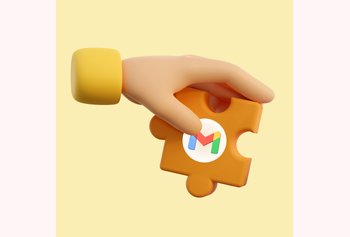Customer Feedback Guide: How to Collect and What to Do With It?
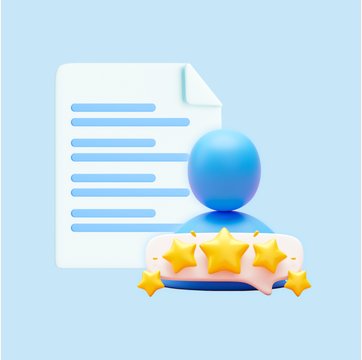
Table of contents
Today, customer feedback has become an important part of decision-making processes in companies. Corporate leaders want to understand the pulse of customers to be able to create more personalized products and experiences.
This explains why companies invest a ton of time and resources in setting up and running feedback channels – emails, review portals, SMS surveys, website analytics, and more.
It’s also proven that when you collect accurate customer feedback and know how to act on it, it’s easier to boost customer satisfaction and retention of customers.
So, that brings us to the question – how do you collect feedback in the right way? What channels do you leverage to get to know your customers?
This article is a deep dive into customer feedback – what it actually means, its importance, ways to collect feedback, and some tips to make this feedback actionable.
Table of Contents
- What is Customer Feedback?
- Why is Collecting Customer Feedback Important?
- 8 Effective Ways to Collect Customer Feedback
- Bonus Tip: Gather Implicit Feedback using Customer Analytics
- What to do with the data you have collected?
- Wrapping Up
What is Customer Feedback?
Customer feedback is information provided by customers about their experience with a product or service. Feedback can be collected proactively by polling and surveying customers, interviewing them, asking for reviews, or implementing the right tools that collect implicit feedback.
The goal is to understand your customers’ needs, identify opportunities for improvement, and ultimately enhance customer satisfaction. Customer feedback has the potential to help teams across the organization – engineering, customer support, marketing, finance, and others – get better at what they do.
Now that you have a fair understanding of what customer feedback is, let’s find out why you need to start listening to customers.
Why is Collecting Customer Feedback Important?
You can’t meet customer expectations if you don’t know what they are in the first place.
How do you know if what you are doing is right or wrong? How do you know if customers like, dislike, or are neutral about your products and services?
This is where customer feedback helps. It’s the guiding light for your company.
With feedback, you can:
- Get a clear understanding of customer needs and expectations
- Identify shortcomings in internal processes and strategies
- Identify dissatisfied customers and find ways to resolve their complaints
- Identify happy customers and come up with strategies to retain them
Keep in mind that customer feedback is not just about improving your product. It has an impact on every aspect of your business – from marketing to sales to customer service.
8 Effective Ways to Collect Customer Feedback
Before collecting feedback from customers, it’s crucial to know why you want their input. Is it to improve a specific aspect of your product? Is it to understand the quality of support you deliver? Having a clear intention would help you design the overall feedback experience.
Once you’ve figured that out, you can reach out to customers for their opinion. There are several ways to do this. Here, we’ll talk about the most popular and effective ways to collect customer feedback.
1. Long Form-based Surveys
Long-form surveys are the most common way of completing the customer feedback loop. It usually includes sending a set of questions through email.
The one thing you have to always keep in mind while sending email surveys is to not get carried away and ask too many questions. Once you learn how to create a survey, collecting feedback will get easier every time.
As per Survey Monkey, the connection between the number of questions and the time spent answering each question is not linear. The more questions your customer survey has, the less time your respondents spend, on average, answering each.
| Number of questions | Average secons spent per question by a participant | Average survey completion times |
|---|---|---|
| 1 | 75 seconds | 1 minute & 5 seconds |
| 2 | 40 seconds | 2 minutes |
| 3-10 | 30 seconds | 2-5 minutes |
| 11-15 | 25 seconds | 5-7 minutes |
| 16-25 | 21 seconds | 7-9 minutes |
| 26-30 | 19 seconds | 9-10 minutes |
It is clear from the above table that the longer the survey, the less time the respondents will spend on each question. There is, however, no ‘ideal’ length for a survey. A few experts do say that anything between 5 and 10 questions is a decent number.
To keep your surveys short, a good rule of thumb to keep in mind is: only ask questions that fulfill your end goal. Ensure that every question serves a clear purpose. If you do not intend to use the information, do not ask that question. The aim is to collect customer feedback and not to have them write an essay.
For example: If you are surveying a customer who has just exited your paid plan, there is no point asking them if the onboarding was easy! Your only aim should be to understand why they are leaving and what can you do to prevent that.
Typically, an email survey can have 4-5 close-ended questions (or multiple choice questions) and one open-ended question. An example of an open ended question is: ‘What do you like the most about our product?’ or ‘Where do you think our product isn’t helping you?’
When to use form-based surveys to collect customer feedback:
The best place to use form-based surveys is when you want detailed inputs and have some open-ended questions to ask your customers. This should only be sent to an engaged user, who you’re sure would like to take the time to provide feedback to you. For instance, if you build online courses as part of your business, form-based surveys are a great method to get feedback from your students as they’re already involved with your material.
With Hiver, for instance, you can customize your feedback forms to include open-ended questions – allowing customers to share their experience, in their own words.
2. Short In-app Surveys
Your customers always have ideas on how to improve your product. They might be looking for a specific feature that’s missing, or find a design that could use a little sprucing up, or stumble upon a glitch that needs fixing.
But most of the time, customers don’t reach out to you until the problem becomes too big to ignore.
A great idea is to offer a survey while your customer is using your app. The survey can be prompted the moment a user has finished interacting with a particular feature in the app. You can implement this feature directly in the app for the convenience of your customers by turning to mobile app development services. Since the user is already in the process of using that feature, it is very likely that their feedback will be very precise and to the point, and not ambiguous.
Remember: Don’t overwhelm them with a long survey. Stick to two to three relevant questions that are specific to the page they’re on.
When to use In-app surveys to collect customer feedback:
When you want quick feedback from someone who has performed a certain action. Timing is of the essence here – you have to trigger the survey at the very moment a transaction ends.
The questions should be specific to what the user is using or has just used, and NOT about the product in general.
3. Customer Satisfaction Score Surveys
A customer satisfaction score indicates how satisfied a customer is with a product, service, or their interaction with a company.
There’s a pretty simple formula to calculate the CSAT score:
CSAT score = [Number of satisfied customer ratings – Number of Not Satisfied ratings] %
The greatest advantage of using satisfaction surveys is that it is very easy to implement and doesn’t require much effort from respondents. You can also capture valuable feedback by sending surveys to collect net promoter scores and customer effort scores.
When to use CSAT to collect customer feedback:
It is useful to periodically measure the level of satisfaction with your customers as they move ahead in their journey. For example, you can send out a CSAT survey after onboarding and training them, after a product or feature has been launched, or after a customer support query has been resolved.
A helpdesk like Hiver allows you to add a CSAT survey at the end of every support interaction.
4. Exit-intent Survey Popup
Exit-intent survey popups are an excellent way to collect customer feedback. They can be used in various different scenarios, but they all have one thing in common: these survey pop-ups are triggered when a visitor is about to leave your website.
The intention behind using these pop-ups is that you can ask your website visitors why they’re leaving. This gives you a fair understanding and insight into their expectations, and why they are abandoning your website.
Ultimately, this would help you identify ways to reduce bounce rates and improve conversion.
An eye-catching and conversion-ready exit-intent survey popup can easily be created with a tool like Popupsmart, a no-code popup builder that allows you to appropriately target your visitors and their behavior.

When to use the exit-intent popup to collect customer feedback:
Exit intent surveys can be used to gather information about why people are leaving your website and what they might want from you in the future. You can ask them to leave a comment or fill out a survey to collect customer feedback before they leave your website.
Remember: You can use this data to serve your visitors’ needs and make the necessary changes to your site.
5. Website Feedback Widgets
Your website is one of the most important resources for your business. You can think of it as your digital real estate.
By incorporating a website feedback widget, you can take opinions from website visitors on anything from product offerings to ease of navigation to the purchase experience. This information can help you identify areas for improvement and ultimately enhance the overall website experience.
Some examples of website feedback questions can be:
- Did you find what you were looking for on our website?
- Was it easy to navigate our website and find the information you needed?
- Did you encounter any technical issues while using our website?
- Were our product/service descriptions clear and easy to understand?
- What improvements would you suggest for our website?
For instance, by using a tool like Marker.io, your customers can capture what they see, add visual annotations, and send that feedback in a couple of clicks.
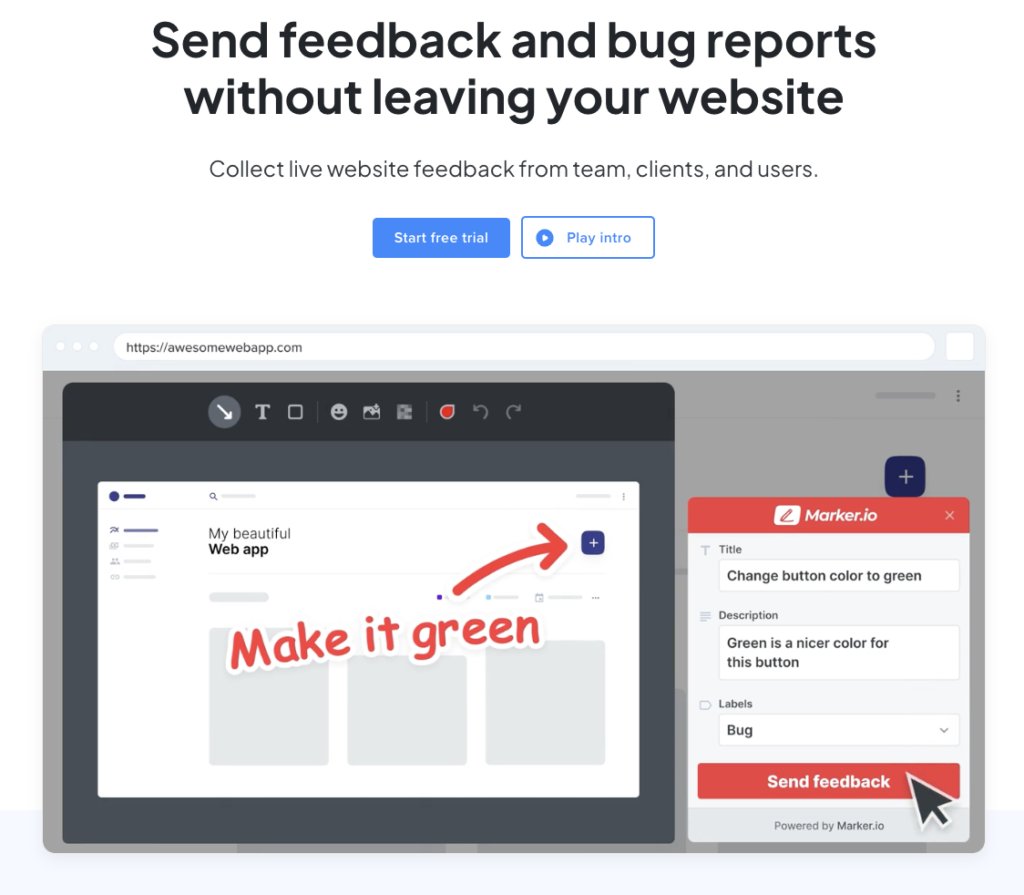
When to use website widgets to collect customer feedback:
When you want to collect feedback on a website, having a widget embedded on your site is the most effective way to go about it.
For instance, you can embed Yelp reviews directly on your site allowing users to share their experiences and provide feedback without switching between channels.
There’s no need for your customers and users to switch back and forth between channels if they need to report a bug or send a suggestion idea.
6. Customer Interviews
While surveys and tests can give you some data, there’s nothing quite like talking to your customers directly. It is a personalized approach that generates the mist accurate responses.
You can do this by either getting on a call with your customers or meeting them face-to-face.
Either approach allows you to understand what the customer truly feels about your company. For instance, when you get on a call with a customer, you can hear the excitement in their voice when they talk about features they like, or the frustration when they describe a problem they’re facing.
It’s a very personalized approach to gathering feedback, but one that can give you the most valuable insights.
The key here is that the person calling the customer should genuinely want to understand their problem and offer solutions. Do not do it because you have to do it. Do it because you care. This is not a sales call.
One more thing to keep in mind is the timing of your calls. According to studies, customers are more likely to respond between 8 am and 9 am, and between 4 pm and 5 pm. On the other hand, lunchtime between 1 pm and 2 pm is the worst time to reach out to anyone.
When to use customer interviews:
It makes sense to get on calls only with your power users, who have deep knowledge about the area you operate in and can give you actionable feedback.
This is not a good avenue when you want to reach out to a lot of people at the same time.
7. Transactional Emails
Transactional emails are the ones that you receive right after signing up for a new service, upgrading to a new plan, and so on. These emails can be easily assembled and scheduled using an email template creator, which will save you a ton of time. Basically, these are emails triggered by a certain interaction between the user and your app.
More often than not, transactional emails are treated as necessary notice and companies would not put much effort into creating a dialogue with the customer.
But contrary to popular belief, transactional emails can be used as a powerful weapon to foster a dialogue with customers. If we look at email open rates, these emails do better than all other emails, says an Experian report. The reason is that people actually want to receive these emails – for instance, they want to know if an upgrade went through or not. Asking the right feedback question in these emails will certainly get good responses.
Viking does a great job at it by asking users to rate their delivery right after they have delivered a product:
In situations when you do not have a question to ask, it’s a good idea to give your users a very easy way of getting in touch with you. Take a cue from Buffer.
Interestingly, the peak-end rule states that ‘our memory of past experience does not correspond to an average level of positive or negative feelings but to the most extreme point and the end of the episode’.
Say a user receives a transactional email just after they’ve upgraded – asking a question at that juncture would evoke positive feelings about the product and set them on the path to customer loyalty.
When to use transactional emails:
When a user does something significant: signs up, upgrades to or exits a plan, and so on. You can send them a quick one-liner question or a short multiple-choice question. The key is to gain insights about their product usability at the right time without burdening them with too many questions.
8. Suggestion Boards
Suggestion boards allow users (customers) to create feedback posts that can be upvoted or commented on by other users. Top posts that have been upvoted or highly commented on can help you discover what the majority of your users need.
The best thing about suggestion boards is that ideas that had been suggested by some customers became popular ideas among others who hadn’t thought of the benefits those ideas could bring.
Aha.io is a wonderful tool for creating these boards.
It is important to make the board very easy to navigate. Users should be able to add new posts with ease. Creating categories, allowing your customers to view the most popular ideas, and making them searchable is key.
Results will take some time to develop. Feedback will not be accumulated immediately. Wait till your users leave enough feedback so that you can determine which ones are popular to your entire base as a whole.
When to use suggestion boards to collect customer feedback:
When you are looking for new ideas or feature requests from your users. Start with inviting power users first – they will be in a better position to suggest improvements, new products and new features.
Then invite more users – they can upvote or comment on others’ ideas even if they do not have one.
Once you’ve collected the feedback you want to pay attention to, the next step is to analyze the data and take actual steps to make things better for all stakeholders.
Bonus Tip: Gather Implicit Feedback using Customer Analytics
There are quite a few critical aspects related to your product and brand that can be uncovered without having to ask your customers any questions. This is where customer analytics come in. Analytics provide you with useful insights about your website, product, and customer journey that can help you improve the customer experience at every touchpoint.
1. Use website analytics to understand user behavior
Seeking explicit customer feedback might help to a certain extent, but the problem is that most visitors will not remember what appealed to them the most before they went ahead and purchased the product. Or they might not be the best at articulating their thoughts.
Instead, website and customer analytics can provide valuable insights into customer behavior, such as which areas of the site visitors frequent, what links they click, and where they drop off.
This analysis will tell you:
- Which areas of your website are interesting and convert the most: By using Hotjar’s heatmaps and screen recordings, you can identify the elements users click the most.
- Which areas of your website are of high friction: It’s very unlikely that users would write to you on the live chat or the customer feedback popup about why they dropped off from your website. Website optimization tools like Crazy Egg offer scroll maps that tell you the exact amount users spend on each section of your website, at what depth do they drop off, and more.
- How your customers behave at every stage of their journey: All businesses have a series of steps/events the users need to go through before they purchase. For example, a user visits the site, signs up for a free trial, and finally pays to subscribe to the product. Mixpanel’s funnel report gives you a bird’s eye view of all the stages – how each stage performs at converting visitors into customers.
- Which elements do customers engage with the most before purchasing your product: There are many marketing elements on a webpage that lead to conversion. Kissmetrics Path Report helps you identify these powerful elements that users click on before converting so that you can optimize them.
2. Understand your power users and potential churners
Who are your power users? They might be the ones who are using all of your features, the ones who spend the most time with your product, or the long-term repeat customers.
Identifying such power users is easy, but pinpointing potential churners can be challenging as many customers may leave without voicing their concerns.
To identify disengaged customers, create a list of actions that demonstrate a lack of interest and map them against your customer base. Use this data to engage with different segments of your customers.
Kissmetrics’ People Search feature can help by identifying visitors who have taken specific actions.
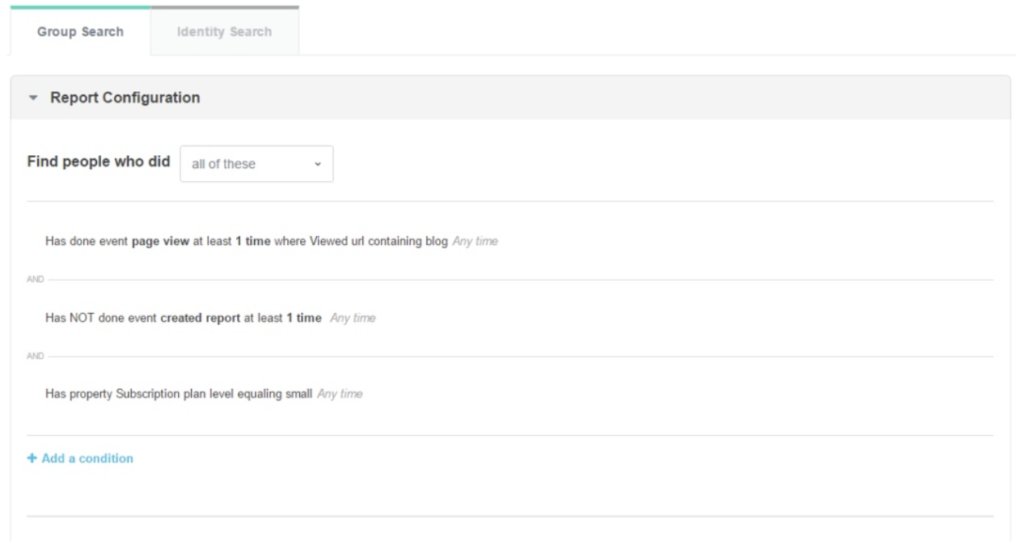
3. Understand which customer segment needs the most attention
Businesses typically have several user segments, such as new visitors, active trial users, first-time buyers, and repeat customers.
The first thing you would want to know is whether a segment is growing or shrinking. This can be done by tracking the behaviour patterns of each segment.
Kissmetrics’ Populations – a customer analytics feature – is great at doing this.
You can define segments, and specify the conditions you’d like them to meet. For example, your first segment can be ‘active trials’ which will contain users who’ve signed up for a trial in the last 30 days.
Populations in Kissmetrics provides an overview of your segments with their size and change over a specified time period. It also shows a trend graph of the total users in a segment. You can use this information to adjust your focus accordingly. Additionally, you can drill down to see more details such as the user’s city and the page they landed on.
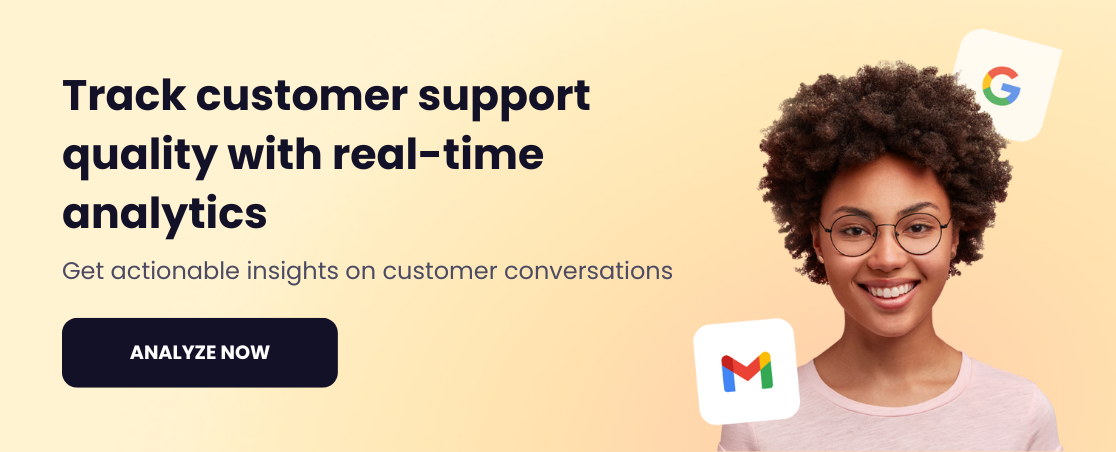
What to do with the data you have collected?
1. Identify product improvement areas
More often than not, your loyal customers would have developed an expertise in your product features; some of our users understand the product as much as our product managers do.
The standup product improvement meetings can only take you so far – the real insight comes from the ones who use your product regularly. This is the product feedback you need to take note of!
No matter how hard you try to empathize with them and put yourself in their shoes, your users will always have some exciting ideas that you did not think of.
So, stop brainstorming and start following the advice your customers give you. Not only will your customers appreciate your willingness to listen and implement their ideas, but you will set yourself apart from your competitors, as a business that genuinely cares.
LEGO Ideas is quite possibly one of the best examples of how customer insight can be used for product development. Enthusiasts can easily submit their own designs on this mini-site. The projects gathering more than 10,000 votes from the community undergo LEGO review and are turned into new sets if the review is favorable.

2. Feed customer feedback into your product roadmap
If companies are able to incorporate customer feedback into the product roadmap successfully, they have certainly come very close to the ideal market fit.
It is crucial to classify feedback into improvements and game-changers. Let’s take a couple of examples from Hiver itself.
- A few of our customers thought shared labels can have different colors as that would help them manage their inboxes better. Now, this is a product improvement – we added it to our ‘task manager’ and had implemented it in almost no time!
- After we built the shared inbox, a few customers suggested we implement automation that will allow emails to be assigned based on a few preset conditions. Now, this is a game-changer as it would significantly reduce the time people spend on task assignments. We added it to our ‘brainstorming session’ and discussed the pros and cons of doing it. It took us a few weeks to build it, but it’s been worth it.
The biggest challenge is to get your customers to suggest. Would they really bother to spend time suggesting a feature?
Fitbit implemented the suggestion boards and noticed that even the ones who did not have a suggestion were either upvoting and downvoting. Ideas suggested by other customers became popular among others who hadn’t thought of the benefits those ideas could bring.
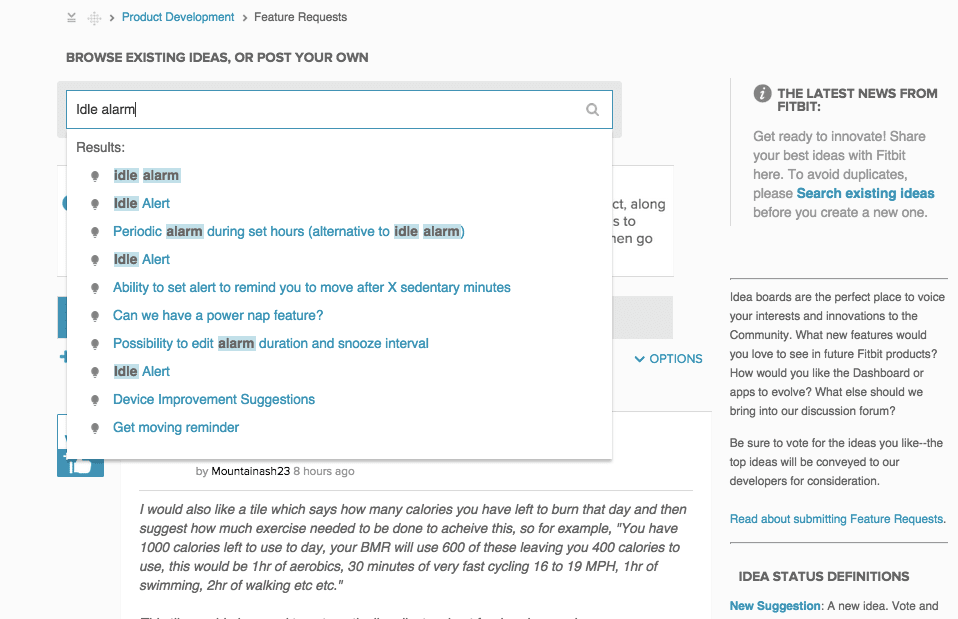
3. Optimize your conversion path
Your website is a goldmine of data. Make sure you utilize this user behavior data to make informed decisions that reduce bounce rates, increase conversion rates and identify leakages in your marketing funnel.
- Lower your bounce rates: With the scroll maps data, identify the high-friction elements of your website that lead to maximum bounce off. Find answers to questions like “Where should you place your calls to action?”, “At what depth do most users drop off?”, “What are the distracting elements that lead to drop-off?”, and more. Optimize these areas on your website to lower your bounce rate and improve conversion rates.
- Prevent leakages in your funnel: For businesses, it is very important to prevent leakages as people move from one stage of the buyer’s journey to another. This does not only apply to signups and purchases, funnels can be put anywhere on your website to know how visitors move through a certain flow. By setting this up, you can understand where you are losing your customers. It then becomes possible to test different iterations of your product and compare the drop-offs between versions.
Analyzing this data will also help you decide what to communicate to customers at every stage in their journey.
You will also have data on how visitors from various sources behave inside the funnel. Once you know what are the highest converting sources, you can put more effort into getting more traffic from those sources.
4. Discover potential advocates and nurture them
Customer satisfaction is the primary indicator of how happy they are with your product. Gathering feedback will help you quickly identify the happiest of your users.
The next step is to nurture them into advocates. Get them sufficiently excited to rave about your product and recommend it to friends and colleagues. Monetary rewards do not motivate advocates. Do simple things – thank you notes are a great idea.
HEX is one cool company that attributes a lot of its success to the handwritten notes they send to their customers.

Imagine a world where most of your new customers came from business referrals. This can be achieved only when you know who your advocates are.
5. Improve your marketing and sales efforts
The information you gain by running customer tests will give you an accurate picture of what your customers really like about your product. The data can be mined specific to individual users/buyers and defined segments.
Analyzing the data, you will be able to pick out product features and marketing elements that they engage with the most, the areas on your website where they spend the most time, and more.
- You can customize your email marketing campaigns based on the behavior displayed by a certain segment of customers.
- You can design special offers and discounts around the features that the customers seem to like the most.
- You can send a free coupon to everybody tied to a particular event. For example, you can send a free usage coupon to users who signed up but did not upgrade. Services like EmuCoupon make it easier for you to offer exclusive coupons to your customers.
- You can adjust your advertisements to target certain profiles of people with specific advertisements. Additionally, the ads can be displayed to match the customer location data.
- You can customize your drip emails based on how the users in different segments interact with your product. For example, if you notice that videos are the best trigger to get people to convert, it is a good idea to send a few videos to users who have just signed up, in the first email to them.
- You can write insightful and engaging content that answers your customers’ queries. If you are trying to become a content writer, it’s better if you make it easy for people to find what they’re looking for, and focus your energy in writing content that is useful, entertaining, and informative.
- The data can also be taken to one-on-one sales conversations. How a person engages with your product will give you enough clues about what they like about your product. This knowledge can be used by sales agents to personalize their conversations.
What links do they click the most, what elements on the website do they interact with the most, how much time do they spend on a page/action – all of this is enough to infer the user’s interests and intents and create a targeted marketing and sales program for them.
6. Prevent customer churn
Are you stuck with the principle that negative feedback should be swept under the rug and kept silent? It is a clear indication that you have set your customer success goal to a low ‘simply meeting customer expectations’. It is crucial to use feedback to improve customer service.
A customer who has taken the effort to call you is a lot more likely to tell their friend about the same problem – ignoring the negative feedback will have a compounding effect.
Negative feedback is an opportunity to prevent customer churn and foster a long-term relationship with the customer. Unhappy customers need a little extra work: call them, understand their pain points and ensure you do your best to make them happy. Ensure that you check on them regularly – make them feel ‘cared’. Showing that you care goes a long way in building a healthy business relationship and ensuring customer retention.
By keeping the two-way conversation open and building trust gradually, you can turn these problem customers into raging evangelists.
Remember: Your customers have taken the time out to give you feedback when they could have just switched to another product. Any feedback is a display of interest in your product. Be wise and use feedback to improve customer service.

7. Find your niche
Most companies are not a hundred percent sure about the verticals they should focus on. It is never an exact science and companies end up spending huge amounts on trial and experimentation.
Customer feedback can be a good way to find out where you belong.
During the process of analyzing feedback from customers from a broad spectrum of verticals, you will begin to see patterns as to where the majority of your happy customers come from.
Once you have discovered the verticals where the majority of your happy customers exist, start working on strengthening the relations you already have with them. Strive to make them your advocates and seek recommendations.
8. Provide amazing customer service
When you know how a customer has behaved on your website, you have a lot of data to make informed decisions about how to deal with them and deliver exceptional customer service. You will be in a better position to understand the problem they’re facing.
Given that you have a fair idea about how they have behaved on the website or with the product, you will be able to anticipate their future needs as well. The links that they have clicked on, the videos they have watched, and the blogs they have read will tell you what appeals to them. You can then talk about those features and make an instant connection with the user.

Wrapping Up
Collecting customer feedback is essential for any business that wants to consistently meet customer expectations and in turn, drive higher revenue.
It doesn’t have to be a tedious task. With the 8 proven methods we’ve shared and the power of customer analytics, you can make it a breeze. The key is to choose the right feedback method that fits your business needs and goals, and to act on the feedback to create a better customer experience.
And when you combine these approaches with a helpdesk solution like Hiver, not only will it be effortless, but it’ll also bring immense benefits to your business.














